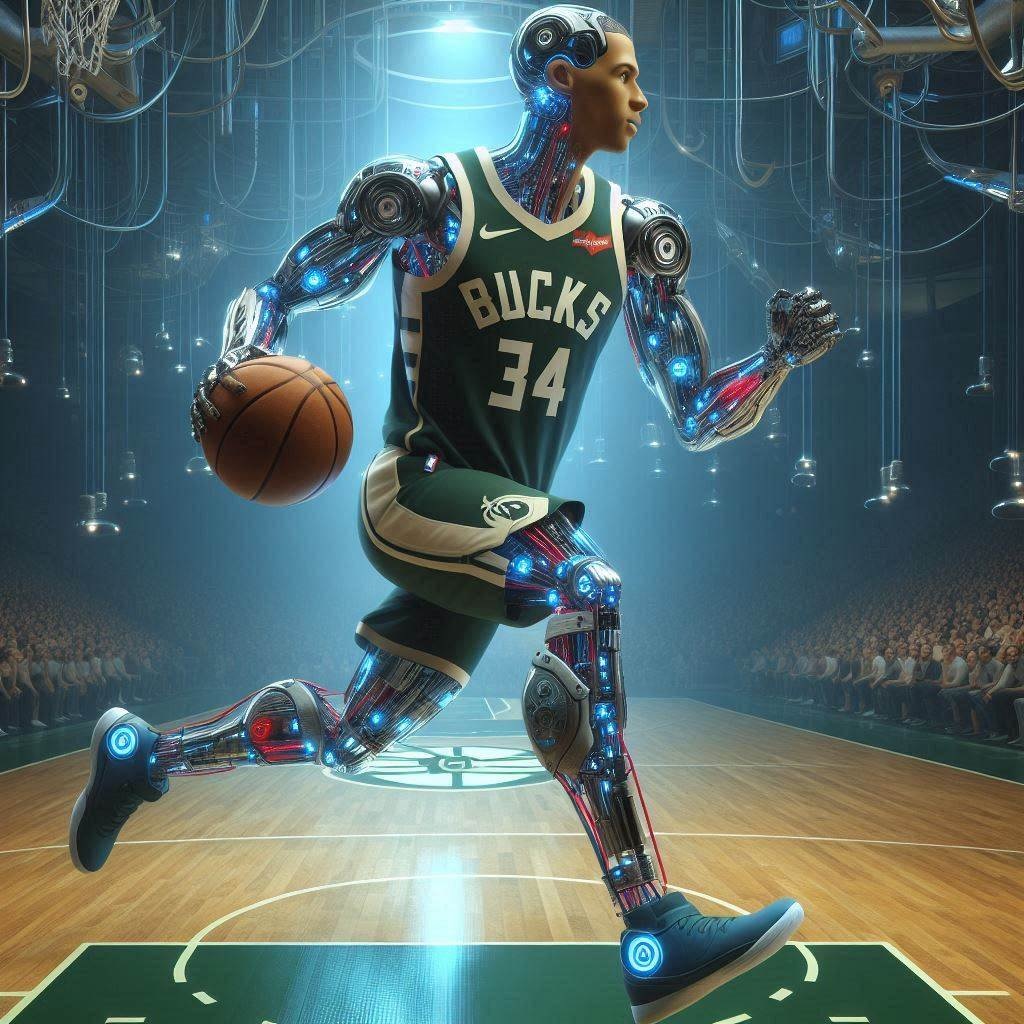Before I even get into the overall picture regarding Giannis look at this:

The man has played for more than a decade in the NBA and he gets the whistle for travelling violations 26 times in a season! (And another 26 they didn’t bother to blow the whistle on him at least.) 3 back court violations? Really Giannis? Palming? 32 offensive fouls? 13 charges? We all know he can’t dribble but maybe he needs to get the memo.
1. Defensive Impact Took a Step Back
Giannis has long been heralded as one of the NBA’s premier defenders, earning the 2020 Defensive Player of the Year award. However, in the 2024-25 season, his defensive impact waned compared to his peak years. While he averaged 1.2 blocks and 0.9 steals per game, these numbers are closer to his career lows than his elite defensive seasons (e.g., 1.5 blocks and 1.2 steals in 2019-20). His Defensive Box Plus-Minus (DBPM), a metric that estimates defensive contribution, dropped to 0.8, down from 1.4 in the previous season and significantly lower than his 2.1 in his DPOY year. This regression is particularly concerning as Giannis enters his age-30 season, where maintaining elite defensive production becomes more challenging.
2. Free-Throw Shooting Remains a Liability
Giannis’ free-throw shooting has been a career-long Achilles’ heel, and the 2024-25 season saw no meaningful improvement. He shot 64.5% from the line on a career-high 10.9 attempts per game, a slight dip from his 65.7% in 2023-24. This poor performance at the stripe continues to hurt the Bucks in close games, especially in the playoffs, where opponents often employ “Hack-a-Giannis” strategies.
Impact of the Decline:
- In clutch situations (final five minutes of games within five points), Giannis’ free-throw struggles were glaring. He converted only 60.2% of his clutch free throws, costing the Bucks valuable points in tight contests.
- His high volume of attempts amplifies the issue. With 10.9 attempts per game, missing roughly 3.9 shots per game translates to nearly 320 missed free throws over an 82-game season—a significant point differential.
3. Playmaking Inconsistency
While Giannis tied his career-high with 6.5 assists per game, his play making became less consistent compared to prior seasons. Posts on X highlighted that his increased reliance on mid-range jumpers and low-post isolations led to more stagnant possessions, reducing his ability to create for teammates. His assist-to-turnover ratio (6.5 assists to 3.4 turnovers) was respectable but unchanged from recent years, indicating no growth in decision-making efficiency.
Key Observations:
- Giannis’ assists often came from straightforward kick-outs or dump-offs rather than complex reads. Advanced metrics like Assist Points Created (APC) show he generated 15.2 points per game via assists, but this figure is lower than playmaking savants like Nikola Jokić (22.7 APC) or Luka Dončić (19.8 APC).
- His tendency to dominate the ball in isolation-heavy sets disrupted the Bucks’ offensive flow, especially when paired with Damian Lillard, whose off-ball movement was underutilized.
4. Three-Point Shooting Regressed
Giannis has never been a prolific three-point shooter, but his 2024-25 season saw a noticeable dip in both volume and efficiency. He attempted only 1.2 threes per game (down from 1.7 in 2023-24) and made them at a career-low 20.7%. This regression limits his ability to stretch defences, allowing opponents to clog the paint and dare clearer shots.
Why It Matters:
- Modern NBA offences rely on spacing, and Giannis’ reluctance to shoot from deep makes it easier for defenders to sag off him. This was evident in games against teams like the Boston Celtics, who packed the paint and forced Giannis into inefficient mid-range attempts.
- His low three-point volume reduces his offensive versatility, as he rarely threatens defences from beyond the arc, unlike other bigs like Karl-Anthony Towns or even Joel Embiid.
Areas Where Giannis Hasn’t Improved
1. Post-Up Scoring Efficiency
Giannis’ post-up game remains a work in progress. Despite his physical dominance, he struggles to convert consistently in the post, especially against savvy defenders who force him into tough fade aways or contested hooks. His post-up efficiency (points per possession) was 0.92, below the league average for big men (0.95). Critics on X noted that his post-up possessions often result in low-percentage shots or turnovers rather than drawing doubles and creating open looks for teammates.
What’s Holding Him Back?:
- Limited Footwork: Giannis relies heavily on power and athleticism rather than refined footwork or countermoves. Defenders who can match his physicality, like Draymond Green or Anthony Davis, often neutralize him in the post.
- Predictability: His go-to moves (spin move or drop-step) are well-scouted, and he hasn’t developed a consistent counter to keep defenders guessing.
2. Off-Ball Movement and Screening
Giannis is not a natural off-ball player, a weakness that persisted in 2024-25. He rarely cuts, sets screens, or relocates to exploit defensive attention, which limits his fit in motion-based offences. Social media posts emphasise his lack of chemistry in pick-and-roll sets with guards like Lillard, as he doesn’t roll hard or set effective screens.
Impact:
- The Bucks’ offence often stagnates when Giannis isn’t the primary ball-handler, as he struggles to create value without the ball. This was evident in games where Lillard or Khris Middleton ran the offence, and Giannis was reduced to standing in the dunker’s spot.
- His screening deficiencies reduce the effectiveness of Milwaukee’s pick-and-roll game, forcing Lillard to create in isolation or rely on other screeners like Brook Lopez.
3. Mid-Range Shooting Stagnation
While Giannis has worked to develop a mid-range jumper, his efficiency in this area hasn’t progressed significantly. He shot 39.4% on mid-range attempts (10-16 feet), roughly in line with his 40.1% in 2023-24. This lack of improvement limits his ability to punish defences that give him space in the mid-post or at the elbow.
Why It’s a Problem:
- Elite bigs like Kevin Durant or Nikola Jokić use mid-range shooting to keep defences honest, but Giannis’ inconsistency allows opponents to focus on rim protection without worrying about pull-up jumpers.
- His increased reliance on mid-range shots (up to 3.1 attempts per game) without improved accuracy led to inefficient possessions, especially in crunch time.
4. Clutch Performance Under Pressure
Giannis’ clutch performance remains a mixed bag. While he delivered standout moments, such as his 59-point, 14-rebound game against the Pistons, his overall clutch stats (last five minutes, game within five points) were underwhelming. He shot 54.2% from the field in clutch situations (down from 58.7% in 2023-24) and, as mentioned, struggled at the free-throw line. His turnover rate in clutch scenarios also rose to 4.1 per 36 minutes, indicating issues with decision-making under pressure.
Key Issues:
- Over-Reliance on Hero Ball: Giannis often resorts to forcing drives or isolations in clutch moments, leading to contested shots or turnovers.
- Lack of Go-To Move: Giannis lacks a reliable crunch-time move to generate clean looks consistently.
As a player entering his prime, Giannis was expected to refine his weaknesses, particularly in shooting and off-ball play, to elevate the Bucks’ championship ceiling.
Looking Ahead: Can Giannis Address These Shortcomings?
Giannis Antetokounmpo’s 2024-25 season was marred by subtle regressions and persistent weaknesses. His defensive impact waned, his free-throw shooting remained a liability, and his play making lacked consistency. Meanwhile, his post-up scoring, off-ball movement, mid-range shooting, and clutch performance showed little to no improvement. While injuries and team context played a role, these shortcomings underscore the challenges Giannis faces as he navigates his prime. For the Bucks to contend in 2025-26, Giannis must address these areas. Otherwise he might as well already prepare some dumb “there is no failure in sports” speech…
Sources Basketball-Reference.com for statistical data / ESPN.com for game logs and advanced stats / RotoWire.com for fantasy and performance analysis / Posts on social media for fan and analyst sentiment

